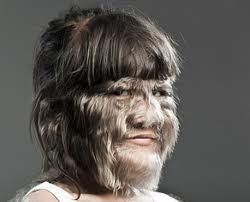

Have you seen a documentary in Discovery Channel of a family with hair all over their bodies? If you do, then their health problem is medically known as Hypertrichosis. While this condition seems to be oddities of nature, there are many factors to learn about this disease.
Based from PubMed, Hypertrichosis or Ambras Syndrome is an abnormal amount of hair growth on the body. Extreme cases are also known as WereWolf Syndrome, just like the face of Wolverine I believe, only to be much more worst.
There are two types of this condition – generalized and localized hypertrichosis. You have generalized hypertrichosis if you have hair growth in your entire body. While localized is focused only in a specific area.
Classifications of Hypertrichosis

Image Credit: www.werewolves.com
Aside from generalized and localized types, hypertrichosis is divided into congenital and acquired classifications.
Congenital Hypertrichosis
Congenital are caused by mutations in the genes, which are very rare to occur compared to acquired form. Congenital hypertrichosis is present from the time of birth, this classification is called as congenital lanuginosa.
Another classification is called generalized congenital hypertrichosis. This condition causes males to have extreme hair growth in the upper body including the face while women have less hair distribution. The palms, soles and mucous membranes are not affected.
Terminal hypertrochosis is another type of congenital that is featured by the presence of pigmented terminal hair which is widely distributed to the entire body. This classification is characterized by thick, dark hair formation, similar with animal hair traits.
Other forms of congenital hypertrichosis are circumscribed, localized and nevoid hypertrichosis.
Acquired Hypertrichosis
There four types of acquired hypertrichosis – lanuginosa, generalized, patterned and localized. Acquired lanuginosa is the rapid growth of lanugo hair, which are commonly in the face, armpit and trunk. The excess hair is also called malignant down, commonly associated with cancer.
Generalized acquired hypertrichosis affects the cheeks, lip, forearm, legs and chin. This classification also include irregular hair growth patterns. Acquired patterned type is an increase in hair growth but in patterned formation. Like generalized, it is also a sign of internal malignancy.
Lastly, acquired localized hypertrichosis is characterized by an increase in hair density and length. This classification doesn’t grow in certain areas of the body.
Causes, Signs and Treatments of Hypertrichosis
Based on WikiPedia, the primary sign of all types of hypertrichosis is excess hair growth that may consist of lanugo, vellus or terminal. As said above, patterned form causes hair pattern growth, generalized forms are characterized by full body hair growth.
The cause of hypertrichosis is either genetics or medically influenced by a medical conditions such as metabolic disorders, cancer or even oral and topical drug treatments. Congenital hypertrichosis lanuginosa is more probably caused by mutation on the 8q chromosome or an spontaneous genetic mutation. Other causes of hypertrichosis is still unknown up to this day.
Unfortunately, this condition cannot be treated but manageable. To deal with hypertrichosis, you need to treat the underlying cause of the disease. Acquired class are mostly triggered by different factors that can be reversed to lessen the effects of hypertrichosis.
Hair removal is the simplest form of hypertrichosis management. There are two types of hair removal – permanent and temporary, both of which are purely cosmetic procedures. Depilation and epilation are applied for hair removal. This includes shaving, trimming, plucking, waxing, sugaring, threading. The result may last to days to several weeks.
The treatments however have side effects such as scarring, dermatitis or hypersensitivity. Permanent hair removal requires chemicals or laser technology to target the root of the hair growth.

No comments:
Post a Comment